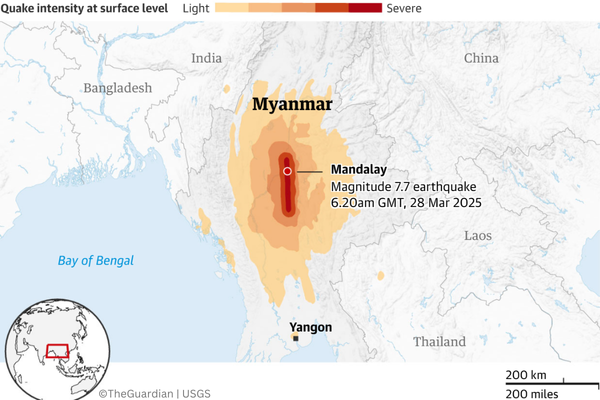On Friday, March 28, 2025, at 12:50 PM MMT (6:21 AM CET), a 7.7 magnitude earthquake struck Myanmar (United States Geological Survey USGS; Helmholtz Centre for Geosciences GFZ), with its epicenter near Mandalay in the central part of the country (The Guardian, 2025). The tremor was also felt in neighboring countries such as Thailand, Bangladesh, India, and China (Myanmar-Now, 2025; Schäfer et al., 2025). It was recorded at a shallow depth of 10 kilometers (Schäfer et al., 2025) or 24 kilometers (GFZ, 2025), with the first aftershock of magnitude 6.4 occurring 12 minutes later (BBC, 2025).
The military junta currently in power in Myanmar declared a state of emergency in six regions (Tagesschau, 2025a; Myanmar-Now, 2025). However, the humanitarian situation is worsening due to the unstable geopolitical climate in Myanmar. Amnesty International has called on the Myanmar military junta to “allow unrestricted access to all humanitarian organizations.” Myanmar expert Joe Freeman reports that the full scale of the disaster in Myanmar may not be clear for some time, as many media outlets are banned and internet access is restricted. As a result, early reports were largely coming from Thailand. The current death toll in Myanmar exceeds 1,700, partly due to the destruction of 60 mosques, where over 700 worshipers were killed during Friday prayers in the holy month of Ramadan. However, the US Geological Survey estimates that the death toll in Myanmar could eventually reach 10,000 (The Guardian, 2025, as of March 31, 2025, 1:30 PM CET).
The earthquake has heavily damaged Myanmar’s transport infrastructure. The main bridges over the Irrawaddy River near Mandalay collapsed, as did the airports in Mandalay and Naypyitaw. Numerous buildings have collapsed. Many roads and bridges are impassable due to landslides and structural damage, further complicating rescue efforts (Schäfer et al., 2025). The Red Cross in Myanmar also warned of the risk that dams on the Irrawaddy River may have been damaged and could break. The river is a critical lifeline for Myanmar (Tagesschau, 2025a).
Unlike the devastating 2004 tsunami that affected the coasts of several Asian countries, this time there is no risk of a tsunami, as the earthquake was not located under the sea and did not reach a comparable magnitude. However, stronger aftershocks cannot be ruled out (Tagesschau, 2025a). Another earthquake of magnitude 5.1 occurred on Sunday, March 30, 2025 (BBC, 2025). Following the 2004 tsunami, tsunami early warning systems were established with international assistance. The decision to develop earthquake early warning systems, however, lies with the affected countries and is influenced by geological and geophysical factors. In Thailand, Myanmar, and other countries in Southeast Asia, such systems are not sufficiently developed (Tagesschau, 2025b; The Guardian, 2025).
What arrived suddenly and unpredictably is essentially the result of geophysical processes, where tensions had built up over the past 50 years without strong earthquakes in the region and were now released through the “locking” of the Indian and Eurasian plates at the Sagaing Fault (Tagesschau, 2025b; Myanmar-Now, 2025; GFZ, 2025; Schäfer et al., 2025).
As of March 31, 2025, 1:30 PM CET
————————————————————————————————————————————————————————
Tagesschau (2025a): Tote und Verletzte durch schweres Erdbeben. Retrieved 28/03/2025 under: https://www.tagesschau.de/ausland/asien/erdbeben-thailand-myanmar-108.html
Tagesschau (2025b): „Frühwarnsysteme für Erdbeben fehlen“. Retrieved 28/03/2025 under: https://www.tagesschau.de/ausland/asien/erdbeben-myanmar-thailand-100.html
Helmholz-Zentrum für Geoforschung GFZ (2025): “GFZ Statement: Erdbeben der Stärke Mw 7,8 in Myanmar
“. Retrieved 28/03/2025 under: https://www.gfz.de/presse/meldungen/detailansicht/gfz-statement-erdbebenereignis-myanmar-mw-78
Deutsche Welle DW (2025): Major earthquake hits Myanmar, felt in Bangkok. Retrieved 28/03/2025 under: https://www.dw.com/en/major-earthquake-hits-myanmar-felt-in-bangkok/a-72065550
Myanmar-Now (2025): Powerful earthquake strikes Myanmar, hitting Sagaing and Mandalay hardest. Retrieved 28/03/2025 under: https://myanmar-now.org/en/news/breaking-7-7-magnitude-earthquake-hits-sagaing-and-mandalay/
The Guardian (2025): Thailand and Myanmar earthquake: death toll rises as Bangkok declared disaster area with dozens trapped under skyscraper – live. Retrieved 31/03/2025 under: unter: https://www.theguardian.com/world/live/2025/mar/28/myanmar-earthquake-thailand-bangkok-mandalay-latest-news-updates#top-of-blog
BBC News (2025): Myanmar earthquake: What we know. Retrieved 31/03/2025 under: https://www.bbc.com/news/articles/crlxlxd7882o
Schäfer, A., Daniell, J., Skapski, J., Mohr, S. & M. Kunz (2025): Mandalay Earthquake Myanmar 2025. Information as of 28th March 2025, 2 pm CET. CEDIM Forensic Disaster Analysis Group (FDA). DOI: 10.5445/IR/1000180552
(Image Source ©The Guardian | USGS)


